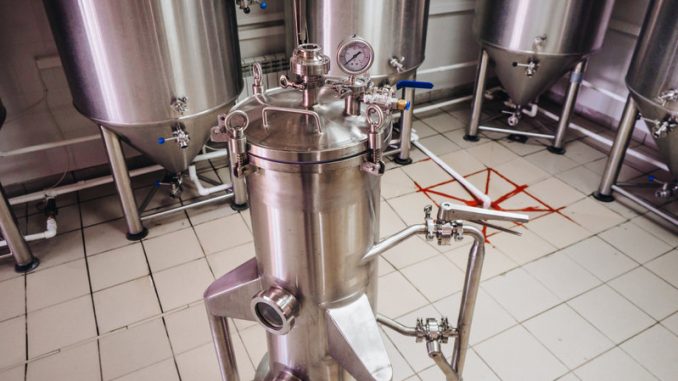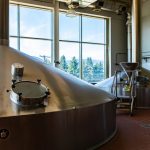
Introduction To Trap Filters
Trap filters, like your draught beer and cider line might not be what gets you excited about brewing but they are an absolute necessity. They are the final guard against unwanted contamination of a beer or cider by particulates such as diatomaceous earth and PVPP (polyvinylpyrrolidone) and shards of metal. Trap filters also help to a certain extent in prefiltration by preventing particles damaging the latter phases of equipment used in sterile filtration and in any packaging.
The use of a trap filter is not an excuse to avoid using sterile filtration. Trap filters are not designed for cleaning up a beer of microbial contaminants especially spoilage bacteria. They can take out some yeast but really not all of them. The microbial sterilization process then by contrast is sometimes known as cold sterilization as well as aseptic processing. That step relies on using membranes with a much smaller pore-size but more of that in a moment.
In Which Part of The Brewing Operation Are Trap Filters Used?
Trap filters are always situated after the equipment used for clarification. This is a common approach and location because clarification of a brew is a such a key part of any process.
In the process of brewing then, there will have been the usual fermentation of yeast producing alcohol from sugars in the fermentation medium. Fermentation, can be primary and secondary, followed by that clarification step to remove material such as spent grain, trub, protein hazes, the yeast, and so on. This leaves a bright beer which is stored and conditioned in the bright tank.
The removal of all fermentation material commonly uses some form of filtration. The most popular system is still to use plate and frame filters but cross-flow filtration and even sedicanters and centrifuges are now being exploited.
Plate and frame filters rely on pads with a filter aid such as diatomaceous earth to remove the yeast, proteins etc. Diatomaceous earth is a particulate fine limestone of diatoms which have been quarried. They commonly have a size distribution of over 1 micron and often get carried as fines into the beer. It is these particulates that need to be removed.
To avoid carry over and protect the product and downstream equipment, the trap filter is set up after the initial clarification process before the bright beer tank. Beer in the bright beer tank is further conditioned where it might then be sterile filtered followed by carbonation. The cold sterile filtration step is always introduced to remove bacteria and yeasts if they happen to have pass through the brewing process. The last step is some form of packaging. Given the delicate nature of the kit used small hard particulates do considerable damage which is why they are removed.
Comparison with Microbial Filtration
Let’s be clear, a trap filter is not used for cold sterilization. These are performed by other types of filtration systems. They are a finer pored membrane or cartridge system with a pore size of 0.45 or even 0.65 microns. These membrane systems are made of nylon filters in a polyethersulphone or polysulphone cartridge and help to trap yeast, spoilage bacteria such as Pedioccoccus and Lactobacillus. The trap filter can retain yeast but that’s not always its primary purpose and shouldn’t be relied upon.
Trap Filters: Their Nature
If you check the web-sites of most food and beverage filtration producers you will find they supply at least one type of trap filter for the special purposes of product protection and human safety.
Most filters are designed as cartridges with a defined pore size. For those not familiar with pore-size ratings, a good trap will retain 98% of all hard particles over a size of 2 microns and above. The next level of rating is 5 microns and any trap will retain 99.99% of these.
The finer pore sizes will retain some yeast. It’s likely that soft gelatinous material could get through a trap filter but a brewer would notice such haze and make adjustments to remedy the situation. It’s not the job of the trap filter to function in removing large soluble polymers – that’s the job of other filtration systems employed such as the plate and frame filter.
Because of HACCP I’d even use a trap filter as a matter of course and specify this at any third-party contractor. It’s something I would look for in the production line and be keen to locate it to inspect its appearance and check any records.
Most trap filters are made of polyethylene and polyethersulphone as the material of choice in the make-up of the filtration medium. A good trap should also demonstrate resistance to damage from harsh chemicals such as sodium hydroxide and sterilants like peracetic acid and hypochlorous acid. They also need to show a high degree of thermal stability to hot liquids of any sort. They also need to be compatible with your operating conditions and actually be certified in terms of the materials used so they don’t also contaminate the brew.
The structure of the trap filter is important attribute. A number of cartridges use graded density depth membranes in a manner which parallels lenticular cartridges. The filtration flow rates can be determined for each operation based on a product flow rate at a specific temperature. Ideally, the beer in the final phase of production is cold so that flow rate is determined at 4ºC.
The brew’s viscosity relative to water is taken into consideration. The relative viscosity of beer at 4ºC is 1.6 and so any measures usually include this factor in flow-rate calculations. Most estimates of trap performance will be judged on the pressure drop across the filter versus the flow rate. For almost all operations, the relationship is linear because beer behaves generally like a Newtonian liquid which is almost perfect.
Filter cartridges used in filtration come in various sizes – expect to see 10-inch, 20, 30 and even 40-inch lengths. The plastic ones are made of polypropylene which is a ubiquitous material for construction and the membranes too are of the same material. These cartridges are designed to operate at a maximum differential pressure of 4.8 bar (70 psid) at 20º C (68ºF). All should withstand a maximum operating temperature on prolonged use of 80°C (176ºF).
Trap filters need to be sterilizable so they can be used a number of times. They should withstand a typical autoclave process using steam of 121ºC and a maximum of 5 cycles of 30 minutes.
After a number of uses, a new cartridge is needed. The removal of the cartridge is determined by a rise in flow-rate or periodic checks on the presence of particulates in the final product.
The benefit of most modern trap filter cartridges is to do away with back flushing. This used to be a common operation for cleaning filters by reversing the flow to such an extent that particles were dislodged and the pores of the filter freshly exposed. Using lenticular designs for filters means that a much larger surface area per volume of cartridge is now available.
The cartridge is also sanitised before use using 80ºC hot water because of the tendency for residual yeast and mould/mold especially to start growing both in the line and in the filter housing as well as on the cartridge.
Trap Filters Need To Meet Food Regulatory Requirements
The other major requirement is that each trap filter must meet the national food specifications. In the USA, all component materials must satisfy FDA Indirect Food Additive requirements which are defined in 21 CFR 177 – 182.
You would expect that each trap filter has a Certificate of Compliance for documentation accuracy and for your records in case there is a the unfortunate occurrence of a contravention or of a spoilt brew. The compliance certificate certifies that the component materials must meet national regulations and that the product was designed and manufactured to stringent specifications assuring its suitability for such demanding beverage filtration applications. It seems a bit heavy but its vital to retain this type of documentation.

Not really thought about trap filters before!